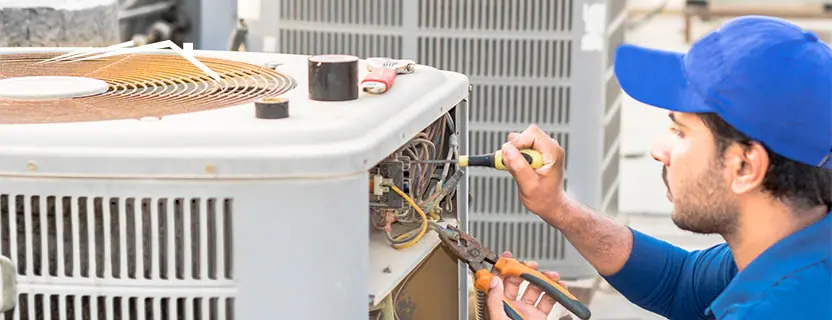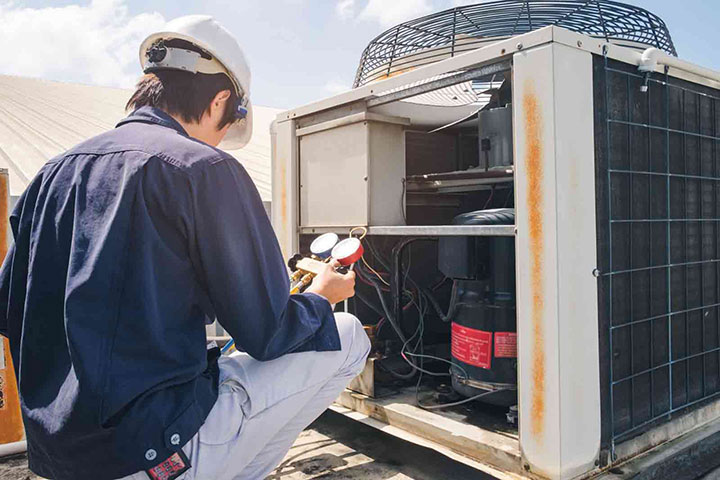Exploring the Providers Offered for Installing a Heat Pump and Heater in Your A/c Configuration
When taking into consideration a new home heating solution, house owners usually face the choice in between heatpump and heating systems - furnace replacement. Each system has unique advantages and downsides. Expert installment plays a crucial function in making sure optimal performance and longevity of the equipment. Understanding the subtleties of the installment procedure can influence the performance of your a/c setup. What certain services can boost the setup experience and guarantee efficiency? The responses might surprise you
Understanding Warm Pumps and Furnaces: Secret Distinctions
Warm pumps and heaters offer the vital feature of regulating interior temperatures, yet they run on fundamentally various principles. Heating systems produce heat by shedding fuel, such as all-natural gas or oil, or by utilizing power to cozy air. This heated air is then distributed throughout the home using ductwork. In comparison, warmth pumps transfer warmth from one place to one more, commonly removing warmth from the outside air or ground, also in cooler temperature levels. This makes them an energy-efficient alternative for both heating and cooling.While heating systems are normally extra efficient in incredibly cold climates, warm pumps can provide year-round temperature level control, adapting to seasonal modifications. The installment requirements additionally differ, as heaters demand ventilation systems for exhaust gases, whereas heat pumps need room for outdoor devices. Recognizing these differences is essential for homeowners assessing their home heating and cooling options.
Advantages of Setting Up a Heatpump
Choosing to install a warmth pump supplies several advantages that can improve home comfort and power efficiency. Warm pumps give both home heating and cooling solutions, making them functional for year-round climate control. Their capability to transfer heat instead of produce it causes reduced energy consumption, which can lead to significant financial savings on utility bills.Additionally, heatpump run silently compared to conventional heating unit, adding to an extra calm home setting. They also require less upkeep, as they have less relocating parts and do not rely upon combustion processes.Moreover, heatpump are eco-friendly, as they utilize renewable resource sources, lowering greenhouse gas exhausts. Their installation might qualify property owners for energy efficiency rebates or tax obligation motivations, even more enhancing the financial advantages. On the whole, warmth pumps stand for an efficient, eco-conscious choice for modern-day cooling and heating systems, ensuring comfort and sustainability.
Benefits of a High-Efficiency Heater
A high-efficiency heating system supplies considerable energy cost savings, which can lead to lowered utility bills for home owners. In addition, these systems contribute to a reduced ecological effect by making use of less gas and launching fewer exhausts. Boosted comfort levels are also a vital benefit, as these heating systems keep more regular temperature levels throughout the home.
Power Savings Prospective
While lots of property owners look for ways to decrease energy bills, purchasing a high-efficiency heater can significantly improve energy savings. These heating systems make use of innovative modern technology to convert a higher percent of fuel into functional warm, significantly improving energy performance. With an Annual Gas Use Efficiency (AFUE) score frequently going beyond 90%, high-efficiency designs can conserve homeowners considerable quantities on their home heating costs compared to common devices. In addition, they run much more quietly and require less frequent repair work, which can even more add to overall financial savings. Over time, the preliminary investment in a high-efficiency heating system commonly settles through reduced energy expenditures, making it a financially wise choice for those seeking to optimize their a/c systems.
Ecological Effect Reduction
Buying a high-efficiency furnace not just benefits property owners financially however likewise greatly decreases environmental effect. These heaters run with raised power effectiveness, which equates to reduce greenhouse gas exhausts. By consuming much less energy, they lower dependence on nonrenewable fuel sources, adding to a reduction in air pollution and aiding fight climate adjustment. In addition, high-efficiency designs commonly make use of advanced technology that reduces waste, further enhancing their environmental benefits. The change to such systems aligns with worldwide efforts to advertise sustainability, urging a move in the direction of renewable resource sources. House owners play a vital duty in fostering a much healthier world while appreciating the benefits of lowered energy costs and boosted functional effectiveness. Such selections show a commitment to ecological stewardship and accountable resource management.
Enhanced Comfort Levels
High-efficiency heating systems substantially improve comfort levels in domestic spaces by preserving much more consistent temperature levels throughout the home. Unlike conventional versions, these innovative systems use variable-speed blowers and regulating gas shutoffs, permitting accurate temperature level adjustments. This modern technology decreases temperature level changes, making sure that each space continues to be uniformly comfy. Furthermore, high-efficiency heaters run silently, adding to a serene interior environment. They also enhance interior air high quality by using advanced filtration systems that record dust and irritants, giving cleaner air for passengers. Moreover, their energy-efficient operation reduces energy costs, making them a cost-effective option over time. Generally, high-efficiency furnaces not only promote a cozy environment but likewise boost the total living experience within the home.
Professional Setup Services: What to Anticipate
What can house owners expect during the professional installation of a heat pump and heating system? A comprehensive evaluation of the home's heating demands will be performed by qualified professionals. This assessment visite site ensures the proper sizing of the equipment, adding to energy efficiency and optimal performance.Once the assessment is complete, the specialists will schedule an installation day, preparing the site for the brand-new system. Homeowners can prepare for a careful setup procedure that consists of establishing the heatpump and heating system, connecting needed ductwork, and guaranteeing correct electrical connections.Technicians will certainly also examine the cooling agent levels and check the system for leaks, guaranteeing whatever runs seamlessly. Home owners must expect clear interaction throughout the procedure, with technicians clarifying each action and resolving any kind of questions. After installment, a presentation of the new system's procedure will certainly be supplied, making sure homeowners understand just how to utilize their brand-new home heating option efficiently.
Regular Maintenance for Optimum Efficiency
After the professional installation of a heatpump and furnace, regular maintenance becomes essential for guaranteeing peak efficiency. This upkeep generally consists of normal examinations and maintenance to determine potential problems prior to they escalate. Service technicians frequently examine the filters, ensuring they are clean and changed as required, as dirty filters can hinder air movement and efficiency.Additionally, inspecting refrigerant levels and ensuring electrical connections are safe is vital for functional safety and effectiveness. Routine upkeep might also include cleaning up the exterior unit of the heatpump to prevent particles buildup, which can affect performance.Moreover, organizing annual tune-ups assists to prolong the life-span of the tools and maintain energy effectiveness. House owners are urged to keep records of upkeep tasks, as this documentation can help in identifying patterns and guaranteeing timely actions. Regular maintenance not only improves convenience yet likewise enhances power usage, bring about cost financial savings over time.
Troubleshooting Common Cooling And Heating Issues
Numerous house owners come across typical HVAC concerns that can disrupt convenience and effectiveness. One prevalent issue is inadequate home heating or cooling, usually triggered by dirty filters, blocked air ducts, or malfunctioning thermostats. A simple check of the air filter can fix air flow problems, while blocked vents ought to be cleared for peak performance.Another regular problem is unusual noises, which may indicate loosened components or mechanical wear. Property owners should pay attention for squeaks or rattles and investigate quickly to avoid further damage. Additionally, frequent biking can signify that the system is large or that a thermostat calibration is needed.Finally, refrigerant leaks in warm pumps can result in reduced efficiency and should be resolved by an expert. Troubleshooting these typical problems can assist in maintaining a comfortable interior atmosphere while expanding the life of the HVAC system. Looking for expert help when necessary warranties that these issues are settled properly and safely.
Cost Factors To Consider for Heat Pump and Furnace Installation

Regularly Asked Questions
How much time Does It Take to Install a Heat Pump or Furnace?
The installment period for a warm pump or furnace generally ranges between 4 to eight hours, depending upon the intricacy of the system, existing facilities, and the experience of the installation team associated with the process.
Are There Financing Options Available for Cooling And Heating Installations?
Funding options for a/c installments differ by provider, usually including flexible settlement plans, lendings, or credit report alternatives. Property owners can explore these alternatives to take care of costs efficiently, making certain convenience upgrades align you can look here with their financial restraints.
What Allows Are Required for Warmth Pump and Furnace Installment?
The necessary licenses for heatpump and heater installation typically consist of building, electrical, and mechanical licenses. Local guidelines might dictate particular requirements, so consulting the regional authority assurances compliance and assists in a smoother setup process.
Can I Install a Heatpump or Heater Myself?
The concern of self-installation for a heat pump or furnace occurs often. Generally, it is a good idea to get in touch with specialists to assure security, conformity with regulations, and optimal performance, as improper installment can cause considerable problems.

What Service Warranties Are Typically Used on Installments?
Warranties on setups typically vary by service provider and devices. Commonly, they may include restricted lifetime warranties on parts, one to five-year labor guarantees, and certain coverage for the system's performance and efficiency, reflecting industry standards. In comparison, warm pumps transfer warm from one area to an additional, typically extracting heat from the outdoors air or ground, also in cooler temperature levels. Their capability to transfer warm instead than produce it results in lower energy intake, which can lead to substantial financial savings on utility bills.Additionally, warm pumps operate silently compared to conventional home heating systems, contributing to a much more relaxed home setting. What can homeowners expect throughout the expert setup of a warmth pump and heater? Homeowners can expect a thorough installation process that consists of setting up the warm pump and heater, linking required ductwork, and ensuring proper electric connections.Technicians will certainly also inspect the cooling agent levels and evaluate the system for leakages, guaranteeing whatever operates perfectly. When thinking about HVAC upgrades, especially the setup of a warmth pump or furnace, recognizing the associated costs is essential for homeowners.